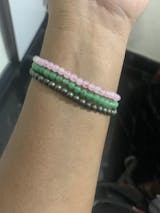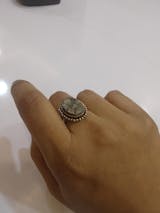The Allure of Pyrite Rings
Pyrite rings have captured the attention of jewelry enthusiasts with their distinctive beauty and unique characteristics. Adorned with natural pyrite gemstones, these rings exude a mesmerizing allure that sets them apart from other gemstone rings. This section will explore the captivating world of pyrite rings, exploring their origins, properties, and significance.
Unveiling the Secrets of Natural Pyrite Rings
Natural pyrite rings hold a certain mystique that draws people in. But what exactly is pyrite, and why are its rings so captivating? We need to understand the gemstone to unravel the secrets of natural pyrite rings. Pyrite, also known as Fool's Gold due to its resemblance to gold, is a mineral that belongs to the sulfide group. It comprises iron and sulfur atoms, creating its unique metallic luster and brassy yellow color. Pyrite is not a valuable metal like gold, yet despite not being precious, it has the same appeal that has long fascinated people.
Natural pyrite rings showcase the beauty and charm of this mineral in an elegant and wearable form. With their rich golden colors and exquisite crystalline formations, these rings make a dramatic statement and give a touch of elegance to any ensemble. The distinct patterns and variations in each pyrite gemstone make each ring unique. Beyond its visual appeal, pyrite is believed to possess powerful metaphysical properties. It boosts vigor, confidence, and assertiveness, making it a popular choice for people looking to increase their power or attract abundance and fortune. To explore the deeper meaning behind pyrite rings, you can read our article on pyrite meaning.
As you embark on your journey with a pyrite ring, it's essential to appreciate its natural beauty and take proper care of this captivating gemstone. In the following sections, we will explore the properties of pyrite rings, discuss how to care for them and debunk common myths and misconceptions surrounding this intriguing gemstone. By uncovering the secrets of natural pyrite rings, you can fully embrace their allure and enjoy the unique charm they bring to your crystal jewelry collection.
Understanding Pyrite
To truly appreciate the beauty and allure of a natural pyrite ring, it's essential to understand the fascinating characteristics of pyrite itself. This section will provide insights into what pyrite is and delve into its formation and composition
What is Pyrite?
Pyrite, also known as fool's gold, is a mineral that belongs to the sulfide group. It is commonly found in sedimentary rocks and often forms associated with other minerals and ores. Pyrite has a distinct metallic luster and a pale brass-yellow color, resembling the appearance of gold. However, unlike gold, pyrite is not a precious metal.
Pyrite crystals exhibit a cubic or pyritohedral shape, with sharp edges and faces that can add a captivating touch to jewelry, including pyrite rings. The mineral's name, derived from the Greek word "pyr," meaning fire, alludes to the sparks produced when striking pyrite against a hard surface.
Formation and Composition of Pyrite
Pyrite is formed through various geological processes. One of the primary methods of pyrite formation is hydrothermal activity, where hot fluids rich in sulfur and iron interact with host rocks. This process can occur in various environments, including volcanic systems, hydrothermal vents, and sedimentary deposits.
The chemical composition of pyrite is iron disulfide (FeS2). Iron (Fe) and sulfur (S) atoms are arranged in a crystal lattice structure. This arrangement gives pyrite its distinct metallic appearance and hardness.
Pyrite often occurs alongside other minerals such as quartz, calcite, and marcasite. These mineral associations can contribute to the variability in the appearance and color of natural pyrite rings. Impurities can result in different shades of yellow, ranging from a pale brass hue to a deeper golden color.
Understanding the nature and composition of pyrite helps to appreciate the unique qualities that make it a popular choice for jewelry, including pyrite rings. In the next section, we will explore the properties of natural pyrite rings, including their appearance, durability, and metaphysical properties.
Properties of Natural Pyrite Rings
Natural pyrite rings possess unique properties of pyrite that make them captivating and sought after by many. Let's explore the key properties of these enchanting rings, including their appearance and color variations, durability and hardness, and energy and metaphysical properties.
Appearance and Color Variations
Natural pyrite rings showcase a mesmerizing beauty that will catch the eye. Pyrite is often called "fool's gold" due to its resemblance to gold. Its metallic luster gives it a dazzling shine, captivating anyone who beholds it. The color of pyrite can vary, with shades of golden yellow, brassy gold, or even a silvery hue. These color variations contribute to the unique allure of each pyrite ring.
Durability and Hardness
One of the remarkable characteristics of pyrite is its exceptional durability. Pyrite is relatively resistant to scratches and external damage, with a Mohs hardness grade of 6 to 6.5. This durability ensures that your pyrite ring can withstand everyday wear without losing its beauty or integrity. However, it is still important to handle your pyrite ring with care to avoid any unnecessary impact or rough handling.
Energy and Metaphysical Properties
Beyond its physical properties, pyrite is also believed to possess metaphysical properties that can enhance one's energy and well-being. It radiates a strong and positive energy that promotes confidence, abundance, and protection. Pyrite is often associated with the solar plexus chakra, which governs personal power and manifestation. Wearing a pyrite ring is believed to help boost self-confidence, attract prosperity, and provide a shield against negative energies.
It's important to note that the metaphysical properties of pyrite are based on beliefs and should be viewed as complementary to any medical or professional advice. If you're interested in learning more about the metaphysical properties of pyrite rings, check out our article on pyrite ring meaning.
Caring for Your Pyrite Ring
Proper care and maintenance are required to guarantee that your natural pyrite ring maintains its beauty and longevity. Here are some guidelines for cleaning, storing, and handling your pyrite ring.
Cleaning and Maintenance
Regular cleaning is essential to keep your pyrite ring looking its best. Pyrite, on the other hand, is a moderately soft mineral that requires cautious handling to avoid scratches or damage. Follow these steps to clean your pyrite ring:
Gently wipe: Use a soft, lint-free cloth to clean off any surface dust or dirt off your pyrite ring.
Mild soapy water: If your pyrite ring requires further cleaning, create a solution of mild dish soap and lukewarm water. Dip a soft cloth or a soft-bristle toothbrush into the soapy water and gently scrub the pyrite ring.
Rinse and dry: Rinse the ring under cool running water to remove any soapy residue. Pat it gently dry with a clean cloth.
Avoid using harsh chemicals, ultrasonic cleaners, or excessive force when cleaning your pyrite ring, as these can damage the stone or its setting. For more detailed instructions on cleaning different types of jewelry, refer to our article on pyrite jewelry.
Storing Your Pyrite Ring
Proper storage is crucial to prevent scratches and damage to your pyrite ring. Consider the following tips:
Separate storage: Store your pyrite ring separately from other jewelry to prevent it from rubbing against harder gemstones or metals that could scratch its surface.
Soft pouch or box: To keep your pyrite ring safe and in contact with other objects, store it in a soft pouch or a jewelry box with compartments.
Avoid exposure: Keep your pyrite ring away from direct sunlight, excessive heat, and humidity, as these conditions can damage the stone.
By following these storage practices, you can help maintain the luster and integrity of your pyrite ring for years to come.
Handling and Wearing Tips
To ensure the longevity of your pyrite ring, it's important to handle and wear it with care:
Avoid contact with chemicals: Remove your pyrite ring before applying lotions, perfumes, or household cleaning products, as these substances can dull the stone's shine.
Gentle touch: Avoid subjecting your pyrite ring to excessive force or impact, as the stone may chip or break.
Regular inspections: Periodically inspect your pyrite ring's setting and prongs to ensure they are secure. Bring your ring to a qualified jeweler for repair if you find any loose stones or damage.
Remember, while pyrite is beautiful, it is not as hard as diamonds or sapphires. Taking these precautions will help preserve the beauty and longevity of your pyrite ring.
Understanding how to care for your pyrite ring properly allows you to enjoy its captivating allure for years.
Debunking Myths and Misconceptions
Pyrite rings have long captured the fascination of jewelry enthusiasts but have also been subject to various myths and misconceptions. This section will debunk some of the most common misunderstandings surrounding pyrite rings.
Pyrite vs. Fool's Gold
One of the most prevalent misconceptions is the confusion between pyrite and fool's gold. While pyrite is often referred to as fool's gold due to its resemblance to gold, it is important to note that they are two distinct minerals. Fool's gold is a term used to describe any mineral that resembles gold but lacks its true value. Pyrite, on the other hand, is a naturally occurring iron sulfide mineral with its unique properties and characteristics.
Pyrite and Wealth
Another misconception is the belief that pyrite has a direct connection to wealth and prosperity. While pyrite's golden metallic luster may give the impression of riches, it does not possess any innate power to attract wealth. Pyrite's association with wealth is primarily symbolic, rooted in its resemblance to gold. It is important to approach pyrite with an appreciation for its natural beauty and unique properties rather than solely focusing on its perceived connection to wealth.
Pyrite's Connection to Healing and Energy
Pyrite is also sometimes associated with healing and energy enhancement. Some believe that pyrite can promote positive energy flow, boost confidence, and provide protection against negative energies. However, it is essential to approach these claims with a critical mindset. While pyrite may hold personal significance for individuals seeking spiritual or energetic benefits, its effects may vary from person to person. It is always advisable to consult a qualified professional or conduct thorough research before ascribing specific metaphysical properties to pyrite.
By debunking these myths and misconceptions surrounding pyrite rings, we can better understand these captivating gemstones' true nature and value. While pyrite may not possess the same characteristics as gold or possess inherent metaphysical properties, it remains a stunning and unique choice for those seeking a distinctive piece of jewelry.















